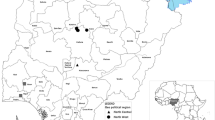Abstract
The composition of the territorial marking pheromones from mandibular glands of males of the beewolvesPhilanthus crabroniformis, P. barbatus, andP. pulcher have been determined. The structures of the components were elucidated by gas chromatography-mass spectrometry and gas chromatography-Fourier transform infrared spectroscopy. The major compound ofP. crabroniformis is isopropyl tetradecanoate, with somewhat lesser amounts of 2-tridecanone, 3-methyl-3-butenyl tetradecanoate, and 92∶8 (Z)∶(E)-11-eicosen-1-ol. The major compounds ofP. barbatus are ethyl tetradecanoate and hexadecanal, which are present in approximately a 60∶40 ratio. These two compounds comprise over 95% of the neutral lipids. Also present in lesser amounts are ethyl dodecanoate, tetradecanal, hexadecan-1-ol, a Δx-octadecen-1-ol, and octadecan-1-ol. The major compounds ofP. pulcher are ethyl (Z)-7-hexadecenoate and geranylgeraniol acetate, which comprise nearly 90% of the neutral lipid fraction, with smaller amounts of tetradecanal, pentadecanal, and ethyl hexadecanoate; trace amounts of Δx hexadecenal, hexadecanal, and octadecanal are also present.
Similar content being viewed by others
References
Ahlquist, L., Bergström, G., andLiljenberg, C. 1978. Acyclic diterpene alcohols: occurrence and synthesis of geranylcitronellol, phytol and geranylgeraniol.Prog. Chem. Fats Other Lipids 16:231–255.
Alcock, J. 1974. The behavior ofPhilanthus crabroniformis (Hymenoptera: Sphecidae).J. Zool., London 173:233–246.
Alcock, J. 1975. Territorial behavior by males ofPhilanthus multimaculatus (Hymenoptera: Sphecidae) with a review of territoriality in male sphecids.Anim. Behav. 23: 889–895.
Blum, M.S. 1981. Chemical Defenses of Arthropods. Academic Press, New York. 562 pp.
Borg-Karlson, A.-K., andTengo, J. 1980. Pyrazines as marking volatiles in philanthine and nyssonine wasps (Hymenoptera; Sphecidae).J. Chem. Ecol. 6(4):827–835.
Buser, H.-R., Arn, H., Guerin, P., andRauscher, S. 1983. Determination of double bond positions in mono-unsaturated acetates by mass spectrometry of dimethyl disulfide adducts.Anal. Chem. 55:818–822.
Cavill, G.W.K., andHoughton, E. 1974. Volatile constituents of the Argentine ant,Iridomyrmex humilis.J. Insect Physiol. 20:2048–2059.
Dettner, K. 1984. Isopropyl esters as wetting agents from the defensive secretion of the rove beetleCoprophilus striatulus F. (Coleoptera, Staphylinidae).Insect Biochem. 14:383–390.
Duffield, R.M., Laberge, W.E., Cane, J.H., andWheeler, J.W. 1982. Exocrine secretions of bees IV: Macrocyclic lactones and isopentenyl esters in DuFour's gland secretions ofNomia bees (Hymenoptera: Halictidae).J. Chem. Ecol. 8:535–543.
Dunkelblum, E., Tan, S.H., andSilk, P.J. 1985. Double-bond location in monounsaturated fatty acids by dimethyl disulfide derivatization and mass spectrometry: application to analysis of fatty acids in pheromone glands of four lepidoptere.J. Chem. Ecol. 11(3):265–277.
Evans, H.E. 1982. Nesting and territorial behavior ofPhilanthus barbatus Smith (Hymenoptera: Sphecidae).J. Kans. Entomol. Soc. 55:571–576.
Evans, H.E., andO'Neill, K.M. 1988. The Natural History and Behavior of North American Beewolves. Cornell University Press, Ithica, New York. 278 pp.
Francis, G.W., andVeland, K. 1981. Alkylthiolation for the determination of double-bond positions in linear alkenes.J. Chromatogr. 219:379–384.
Francke, W., Levinson, A.R., Jen, T.-L., andLevinson, H.Z. 1979. Carbonsäure-isopropylester—ein neue klasse von insektenpheromonen.Angew. Chem. 91:843–844.
Free, J.B., Williams, I.H., Pickett, J.A., Ferguson, A.W., andMartin, A.P. 1982. Attractiveness of (Z)-11-eicosen-1-ol to foraging honeybees.J. Apic. Res. 21:151–156.
Gwynne, D.T. 1978. Male territoriality in the bumblebee wolf,Philanthus bicinctus (Mickel) (Hymenoptera: Sphecidae): Observations on the behaviour of individual males. Z.Tierpsychol. 47:89–103.
Hedin, P.A., Davis, F.M., Dickens, J.C., Burks, M.L., Bird, T.G., andKnutson, A.E. 1986. Identification of the sex attractant pheromone of the southwestern corn borerDiatraea grandiosella Dyar.J. Chem. Ecol. 12:2051–2063.
McDaniel, C.A., andHoward, R.W. 1985. Mass spectral determination of aldehydes, ketones, and carboxylic acids using 1,1-dimethylhydrazine.J. Chem, Ecol. 11:303–310.
McDaniel, C.A., Howard, R.W., O'Neill, K.M., andSchmidt, J.O. 1987. Chemistry of male mandibular secretions ofPhilanthus basilaris Cresson andPhilanthus bicinctus (Mickel) (Hymenoptera: Sphecidae).J. Chem. Ecol. 13:227–235.
O'Neill, K.M. 1979. Territorial behavior in males ofPhilanthus psyche (Hymenoptera, Sphecidae).Psyche 86:19–43.
O'Neill, K.M. 1983. Territoriality, body size, and spacing in males of the beewolfPhilanthus basilaris (Hymenoptera; Sphicidae).Behaviour 86:295–321.
Opdyke, D.L.J. 1976. Isopropylmyristate.Food Cosmet. Toxicol. 14:323–326.
Schmidt, J.O., O'Neill, K.M., Fales, H.M., McDaniel, C.A., andHoward, R.W. 1985. Volatiles from mandibular glands of male beewolves (Hymenoptera: Sphecidae,Philanthus) and their possible roles.J. Chem. Ecol. 11:895–901.
Schmidt, J.O., McDaniel, C.A., andSimon Thomas, R.T. 1990. Chemistry of male mandibular gland secretions ofPhilanthus triangulum.J. Chem. Ecol. 16:2135–2143.
Schwartz, D.P., Brewington, C.R., andWeidhranch, J.T. 1972. Methods for the isolation and characterization of constituents of natural products. XVII. A simple microhydrogenation technique.Microchem. J. 17:677–681.
Scribe, P., Guezennec, J.D., Pepe, C., andSaliot, A. 1988. Identification of the position and stereochemistry of the double bond in monounsaturated fatty acid methyl esters by gas chromatography/mass spectrometry of dimethyl disulfide derivatives.Anal. Chem. 60:928–931.
Simon Thomas, R.T., andPoorter, E.P.R. 1972. Notes on the behaviour of males ofPhilanthus triangulum (F.) (Hymenoptera, Sphecidae).Tijdschrifi Etomol. Deel. 115:141–151.
Author information
Authors and Affiliations
Rights and permissions
About this article
Cite this article
McDaniel, C.A., Schmidt, J.O. & Howard, R.W. Mandibular gland secretions of the male beewolvesPhilanthus crabroniformis, P. barbatus, andP. pulcher (Hymenoptera: Sphecidae). J Chem Ecol 18, 27–37 (1992). https://doi.org/10.1007/BF00997162
Received:
Accepted:
Issue Date:
DOI: https://doi.org/10.1007/BF00997162




